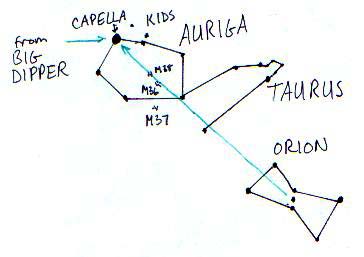
The name Capella means "she-goat," and three smaller stars nearby are called The Kids. What does that have to do with a charioteer, you may ask? Good question. One story has it that the charioteer was responsible for the royal livestock, and would quite reasonably be toting goats around on his shoulder. And Auriga couldn't be a herdsman, because there is already a herdsman, Bootes, on the other side of the side of the night sky.
The spicier legend of Auriga completely ignores the goats. Zeus meddled with his son's health, causing his grandson Erechtheus to be born disabled. Erectheus then invented the chariot, a sort of proto-wheelchair, so he get around by himself.
Orion, like the Big Dipper, is often used as a pointer to other night sky objects. In fact, both of those constellations, as well as Taurus, point to Auriga. Try any of these methods to confirm that your have found Auriga:
1. Follow a line away from the handle of the Big Dipper, through the two stars on the top side of the bowl. Capella is 50 degrees away.
2. Taurus touches Auriga. The star at the end of the top horn is usually drawn in maps as being part of both constellations, although it technically belongs only to Taurus.
3. Capella is about 45 degrees from the middle belt star in Orion. A line between the two will pass through the star in Taurus that abuts Auriga.
Auriga is also right on the winter Milky Way. Trace a patch from Cygnus in the west, though Cassiopeia high in the north, and on to Auriga. The winter Milky Way is not as brilliant as the summer Milky Way, but it gives Auriga some star clusters. M36, M37, and M38 are all visible as hazy patches with binoculars, and even small telescopes will bring in some nice details, especially on M37.

The Piker Press moderates all comments.
Click here for the commenting policy.